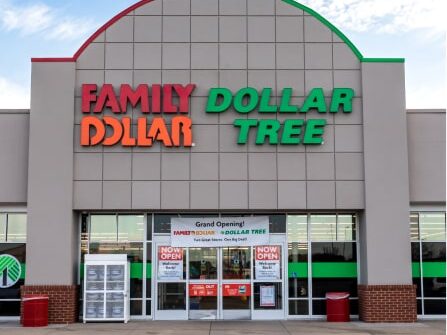1. Rising Inflation

Inflation has had a significant impact on dollar stores, as the rising cost of goods and transportation has made it increasingly difficult for these retailers to maintain their low prices. Dollar stores are built on the premise of affordability, but inflation forces them to raise prices or reduce product quality, alienating their core customer base.
According to The Wall Street Journal, many dollar stores have had to introduce multi-dollar price points, undermining the “dollar store” branding that once defined them. As prices continue to rise, these stores struggle to retain their appeal as a low-cost shopping destination.
2. Supply Chain Disruptions

Ongoing supply chain issues have hit dollar stores particularly hard. These retailers rely on sourcing inexpensive goods from international suppliers, and disruptions in shipping and manufacturing have led to empty shelves and inconsistent inventory.
As highlighted by Reuters, many dollar stores are unable to replenish stock quickly enough, frustrating loyal customers who depend on these stores for everyday essentials. Without reliable inventory, customer satisfaction declines, and stores lose business to competitors with more stable supply chains.
3. Competition from Big-Box Stores

Dollar stores face fierce competition from big-box retailers like Walmart and Target, which offer competitive pricing on a wider variety of goods. These larger retailers often have better resources to absorb rising costs and provide superior customer experiences, such as online shopping and in-store pickup options.
According to Forbes, big-box stores are increasingly attracting budget-conscious shoppers who might have previously relied on dollar stores. The convenience and variety offered by these retailers make it harder for dollar stores to compete.
4. Online Shopping Boom

The rapid growth of e-commerce has shifted consumer behavior, with more people opting to shop online for convenience and savings. Platforms like Amazon offer competitive prices, fast delivery, and a broader selection of goods, drawing customers away from brick-and-mortar dollar stores.
As noted by Digital Commerce 360, the rise of online shopping has been particularly challenging for dollar stores, which have been slow to invest in e-commerce capabilities. Without a robust online presence, these stores risk becoming obsolete in the digital age.
5. Declining Product Quality

Dollar stores are often criticized for offering low-quality products, which can deter repeat customers. Items like cheap electronics, poorly made household goods, and subpar food products fail to meet the expectations of modern consumers, who are increasingly seeking value for their money.
According to Consumer Reports, shoppers are becoming more discerning about the quality of products they purchase, even when shopping on a budget. Dollar stores’ reputation for poor quality may drive customers to competitors that offer better value, even at slightly higher prices.
6. Over-Saturation of the Market

The rapid expansion of dollar stores has led to market over-saturation, with too many locations competing for the same pool of customers. Chains like Dollar Tree and Dollar General have opened thousands of new stores in recent years, but this aggressive growth strategy has made it difficult for individual locations to remain profitable.
As reported by CNN, the over-saturation of dollar stores in certain areas has created a scenario where locations cannibalize each other’s sales. This unsustainable growth model puts additional pressure on already struggling stores.
7. Lack of Fresh Food Options

One of the biggest criticisms of dollar stores is their lack of fresh food options. Many locations primarily stock processed foods, canned goods, and snacks, leaving customers with limited access to healthier choices like fresh produce, dairy, and meat. This issue has alienated consumers who are increasingly prioritizing health and nutrition.
According to The New York Times, dollar stores’ reliance on non-perishable items stems from their low-margin business model, which makes it difficult to handle the logistics of fresh food distribution. However, as consumers demand healthier options, the inability to adapt may cause dollar stores to lose relevance.
8. Poor Employee Working Conditions

Dollar stores have faced widespread criticism for their low wages, limited benefits, and poor working conditions. Many employees report understaffed stores, long hours, and a lack of support from management. These issues contribute to high turnover rates and low morale among workers.
As noted by Business Insider, unhappy employees often lead to poor customer experiences, with unstocked shelves, long checkout lines, and lackluster service driving shoppers away. Dollar stores’ unwillingness to invest in their workforce may be contributing to their decline.
9. Dependence on Economically Distressed Areas

Dollar stores often thrive in economically distressed areas where consumers rely on them for affordable essentials. However, this dependence on low-income neighborhoods has drawn criticism for perpetuating economic inequality and limiting access to better-quality goods. Some communities have even introduced legislation to restrict the opening of new dollar stores.
According to The Atlantic, these stores can stifle local economies by driving out independent grocers and other retailers. As public sentiment shifts against the over-proliferation of dollar stores, their future in these communities is increasingly uncertain.
10. Environmental Concerns

Dollar stores are notorious for contributing to environmental issues due to their reliance on cheaply made products that are often disposable or poorly packaged. This business model encourages a culture of single-use items and waste, which is increasingly at odds with consumer values centered around sustainability.
As highlighted by Greenpeace, many shoppers are turning to retailers that offer eco-friendly products and packaging. Dollar stores’ failure to adapt to this shift could alienate environmentally conscious consumers and further erode their customer base.
11. Limited Digital Transformation

In an era where digital integration is crucial to retail success, dollar stores have lagged behind competitors in adopting new technologies. Many locations still rely on outdated point-of-sale systems, offer limited online shopping options, and lack loyalty programs or mobile apps to engage customers.
According to Retail Dive, companies that embrace digital transformation, like Walmart and Target, are better equipped to meet the needs of tech-savvy shoppers. Dollar stores’ reluctance or inability to invest in technology puts them at a significant disadvantage in an increasingly digital marketplace.
12. Eroding Brand Perception

Perhaps one of the most significant challenges dollar stores face is their eroding brand perception. Once seen as a reliable source of bargains, many consumers now associate these stores with low-quality products, empty shelves, and poor customer service. This negative perception makes it harder for dollar stores to attract and retain customers, especially as competition intensifies.
According to Forbes, rebuilding brand trust will require dollar stores to focus on improving the customer experience, enhancing product quality, and investing in employee satisfaction. Without these changes, dollar stores may continue to struggle to maintain their place in the retail landscape.
